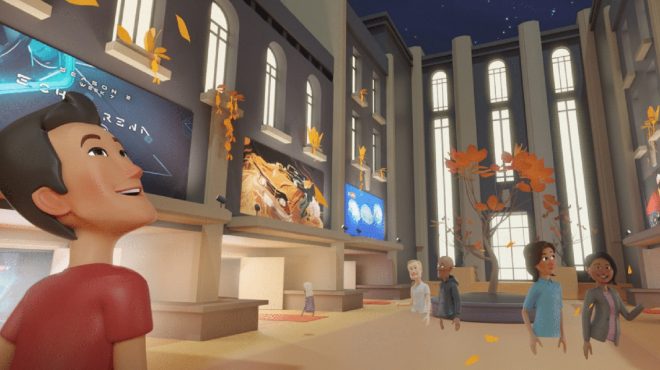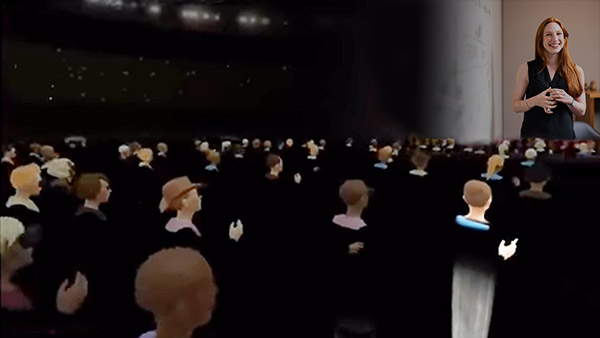ETIP #292
Virtual reality can take higher education to new heights

Hybrid and remote learning are here to stay at U.S. colleges, universities and grade schools. And while these new teaching modalities pose some challenges for professors and students, they also offer opportunities for new interactive educational experiences. In particular, virtual reality provides a perfect platform to erase the distance from distance learning.
For this article we spoke with VR experts, Bryan Yee and Jay Miolla. Jay is a VR veteran and Managing Director of The Cuttlefish, a company that specializes in immersive, location-based experiences. Bryan is a VR developer who is teaching a Cornell University summer workshop entirely in virtual reality. The workshop title Curating the Future is part of the Millstein Program series that encourages students to investigate the social and political context of technology.
Lose your misconceptions about VR in higher education
According to Bryan Yee, “The first misconception you have to get over is that you can’t be effective as an educator in VR. When you understand the medium and tailor your content to it, you can teach in ways that weren’t possible before.”
“Every teacher is figuring out how to be a virtual professor,” says Jay Miolla. “The notion of a virtual professor is changing on the fly. But virtual teaching is absolutely more successful for the people who look for new ways to use the tech.”

Both Bryan and Jay said one of the biggest missteps they see when educational institutions jump into VR is that they try to recreate previous educational experiences in the new space. On the flip side, they recommend embracing once of the best things about VR: that it allows experiential teaching in a new way. You just have to be willing enough to let go of the old so that you can embrace the new possibilities.
When you understand the medium and tailor your content to it, you can teach in ways that weren’t possible before. — Bryan Yee, Workshop Lead at Cornell University
VR allows students to get hands-on
At Cornell, Bryan’s students meet in a VR space called The Platform. The space allows students using an Oculus Quest to interact in VR using their real hands instead of controllers. Immediately, seminar participants began to hug or high-five when they got together—much-needed social connections during a summer of lockdown.
When Bryan realized his students were responding to this pent-up need for physical interaction, he actually modified elements of the curriculum to be more physically interactive. He took greater advantage of the tactile capabilities of the Oculus Quest, and, to introduce the concept, he created a jukebox students could bang to turn on the music, in the style of Arthur Fonzarelli of “Happy Days”. While the cultural reference might have been lost on his Gen Z students, the fun certainly wasn’t.
Put students at the center of the VR education experience
Jay Miolla says, “Zoom is only effective for announcements. Collaboration is a challenge. But there’s potential in creating individualized experiences that can be delivered in education.”
Putting students at the center is one of the core tenets of active learning, and it’s one way that VR excels. Because VR in a shared space is about collaboration—not one-way monologue.
Zoom is only effective for announcements. Collaboration is a challenge. — Jay Miolla, Managing Director, The Cuttlefish.
Bryan’s Curating the Future workshop for Cornell is all about helping students develop skills creating for Unity 3D, the most widely used 3D rendering engine.Following the rollout of the interactive object feature to The Platform, students can now curate their own space and fill it with their own objects created using Unity. This self-guided approach to creation allows them to teach themselves and teach each other — while building confidence in their skills. Bryan joked, “I think they actually teach each other more than I teach them.”
Get ready to experiment
No one has all the solutions at this moment for how to best deliver remote and hybrid learning. It’s about experimenting and adapting. And that means getting comfortable with trying new things. For instance, Bryan Yee and his fellow lecturers started holding faculty meetings in VR to get more people comfortable with the technology.
You’re not just teaching, you’re also learning. — Bryan Yee
Jay Miolla says, “We’re very early in the adoption curve for immersive tech. The pitfall to avoid is using it solely for the whiz-bang value. The real, lasting uses of VR are not the attempts to replace existing classroom experiences, they’re about doing things that you can’t do any other way.”
Bryan adds, “The most important thing to remember is that you’re not just teaching, you’re also learning. You’re learning and exploring how to reach and teach your students. You can modify and be responsive to what you’re seeing. AR, VR, virtual platforms give you more flexibility to shape the experiment with your students.”
Here’s what you can do right now
Both Bryan and Jay recommend that any college, university or grade school interested in offering VR educational experiences should prepare by getting hands on with the technology now. “Getting the equipment is the key,” says Bryan. “Tech equality is an important aspect of making this work. When creating or meeting in VR, it’s about providing students an even playing field.”
Start experimenting now to find your fit. — Jay Miolla
There are many different hardware offerings and scores of software solutions that can be adapted for VR education. “You have to build your curriculum to account for the technology, and that takes some pre-work,” says Bryan Yee. Jay Miolla adds, “Start experimenting now to find your fit. Keep the outcome in mind—it’s about delivering something new and better, rather than replicating what you used to do in the classroom.”
Starmark and our friends, Bryan and Jay, have tons of experience developing and deploying AR and VR experiences that solve modern problems. If you’re not sure where to start, get in touch with us. And definitely check out our eight-step guide to getting your first AR project off the ground.
